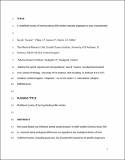Files in this item
A multilevel society of herring-eating killer whales indicates adaptation to prey characteristics
Item metadata
| dc.contributor.author | Tavares, Sara B. | |
| dc.contributor.author | Samarra, Filipa I. P. | |
| dc.contributor.author | Miller, Patrick J. O. | |
| dc.date.accessioned | 2017-12-30T00:31:56Z | |
| dc.date.available | 2017-12-30T00:31:56Z | |
| dc.date.issued | 2017-04 | |
| dc.identifier | 248756784 | |
| dc.identifier | 26d20538-b209-45a2-b90b-5a3a198e708d | |
| dc.identifier | 85020231816 | |
| dc.identifier | 000401769000025 | |
| dc.identifier.citation | Tavares , S B , Samarra , F I P & Miller , P J O 2017 , ' A multilevel society of herring-eating killer whales indicates adaptation to prey characteristics ' , Behavioral Ecology , vol. 28 , no. 2 , pp. 500-514 . https://doi.org/10.1093/beheco/arw179 | en |
| dc.identifier.issn | 1045-2249 | |
| dc.identifier.other | RIS: urn:C3B83194CCCBA825C4FB19D1484C8470 | |
| dc.identifier.other | ORCID: /0000-0001-7216-6913/work/30173076 | |
| dc.identifier.uri | https://hdl.handle.net/10023/12396 | |
| dc.description | This work was supported by the Fundação para a Ciência e a Tecnologia (grant numbers SFSFRH/BD/30303/2006 and SFRH/BD/84714/2012); Icelandic Research Fund (i. Rannsóknasjóđur, grant number 120248402); National Geographic Society Science and Exploration Europe (grant number GEFNE65-12); Office of Naval Research (grant number N00014-08-10984); and a Russell Trust Award from the University of St. Andrews. | en |
| dc.description.abstract | Non-social factors can influence animal social structure. In killer whales (Orcinus orca), fish- versus mammal-eating ecological differences are regarded as key ecological drivers of their multilevel society, including group size, but the potential importance of specific target prey remains unclear. Here, we investigate the social structure of herring-eating killer whales in Iceland and compare it to the described social structures of primarily salmon- and seal-eating populations in the Northeast Pacific, which form stable coherent basic units nested within a hierarchical multilevel society. Using 29023 photographs collected over 6 years, we examined the association patterns of 198 individuals combining clustering, social network structure, and temporal patterns of association analysis. The Icelandic population had largely weak but non-random associations, which were not completely assorted by known ranging patterns. A fission–fusion dynamic of constant and temporary associations was observed but this was not due to permanent units joining. The population-level society was significantly structured but not in a clear hierarchical tier system. Social clusters were highly diverse in complexity and there were indications of subsclusters. There was no indication of dispersal nor strong sex differences in associations. These results indicate that the Icelandic herring-eating killer whale population has a multilevel social structure without clear hierarchical tiers or nested coherent social units, different from other populations of killer whales. We suggest that local ecological context, such as the characteristics of the specific target prey (e.g., predictability, biomass, and density) and subsequent foraging strategies may strongly influence killer whale social association patterns. | |
| dc.format.extent | 15 | |
| dc.format.extent | 1997426 | |
| dc.language.iso | eng | |
| dc.relation.ispartof | Behavioral Ecology | en |
| dc.subject | Ecological context | en |
| dc.subject | Hierarchical structure | en |
| dc.subject | Killer whale | en |
| dc.subject | Multilevel societies | en |
| dc.subject | Orca | en |
| dc.subject | Social structure | en |
| dc.subject | GE Environmental Sciences | en |
| dc.subject | QH301 Biology | en |
| dc.subject | QL Zoology | en |
| dc.subject | NDAS | en |
| dc.subject.lcc | GE | en |
| dc.subject.lcc | QH301 | en |
| dc.subject.lcc | QL | en |
| dc.title | A multilevel society of herring-eating killer whales indicates adaptation to prey characteristics | en |
| dc.type | Journal article | en |
| dc.contributor.sponsor | Office of Naval Research | en |
| dc.contributor.institution | University of St Andrews. School of Biology | en |
| dc.contributor.institution | University of St Andrews. Sea Mammal Research Unit | en |
| dc.contributor.institution | University of St Andrews. Scottish Oceans Institute | en |
| dc.contributor.institution | University of St Andrews. Marine Alliance for Science & Technology Scotland | en |
| dc.contributor.institution | University of St Andrews. Institute of Behavioural and Neural Sciences | en |
| dc.contributor.institution | University of St Andrews. Centre for Social Learning & Cognitive Evolution | en |
| dc.contributor.institution | University of St Andrews. Bioacoustics group | en |
| dc.identifier.doi | https://doi.org/10.1093/beheco/arw179 | |
| dc.description.status | Peer reviewed | en |
| dc.date.embargoedUntil | 2017-12-29 | |
| dc.identifier.url | https://academic.oup.com/beheco/article-lookup/doi/10.1093/beheco/arw179#supplementary-data | en |
| dc.identifier.grantnumber | N00014 08 1 0984 | en |
This item appears in the following Collection(s)
Items in the St Andrews Research Repository are protected by copyright, with all rights reserved, unless otherwise indicated.

